According to the New York Times, there is a shortage and backorder of bicycles this summer due to COVID-19, especially in the cities where public transportation is discouraged. Fortunately, in NEPA, the problem is not so extreme. For those who have a bike, now might be a good time to dust them off and enjoy the many beautiful and well-maintained trails are available at the Countryside Conservancy at Lackawanna State Park, other locations in the Abingtons or the Lackawanna Heritage Valley Authority.
However, whether you head out for 5 or 50 miles, ensuring a proper bike fit should be on your checklist. Riding a bicycle that is properly fit to your style and body will not only help to prevent injury, but allow for a more comfortable riding experience. There are many things to take into consideration when checking your bike fit. First and foremost you must choose a bike that fits your style of riding.
For the sake of simplicity 3 basic styles of bikes include Road bikes, Hybrid bikes and Mountain bikes. Road bikes are designed for long distance riders, hybrid bicycles can be used for longer distance riders, but usually accommodates a recreational cyclist, and mountain bikes are designed for dirt or gravel and technical trails. The next component of ensuring a proper bike fit is making sure that you have a good foundation by choosing the right sized frame. To find the right sized frame you can use the following guidelines as a way to start or simply ask the local bike shop or bike fit consultant of your choice for help.
Road bikes: When straddling the bike you should have about 1” of clearance between your body and the top tube if the bike has a straight top tube (which runs parallel to the ground). When lifting the bike you should have 1” clearance between the tires and the ground. If the bike has a sloping top tube (semi-compact design) you should have a clearance of 2” or more.
Mountain bikes: When straddling the bike lift the bike off the ground and you should have a minimum of 2” clearance between the ground and the tires. With full suspension bikes you will want 1”-2” standover clearance because when you sit on the bike the frame will become lower from compressing the suspension. More aggressive riders will likely have 3”-5” of clearance.
Comfort bikes: Standing over a comfort bike to chose the right sized frame is not necessary. They are commonly designed with a steep sloping top tube and allow the rider to put feet firmly on the ground when the rider comes to a stop.
Now that you have right size for your bike you should adjust the components of the bike to allow for a more comfortable riding experience. Please use the diagram as a point of reference for the following tips. Also be sure to reexamine your bike fit after any bad falls. Keep in mind these measurements are meant to be used as a simple guideline and if you have any pre existing injuries or concerns please be sure to consult your local Physical Therapist or bike fit consultant.


Handlebars (HB)
Knee to Pedal
Foot to Pedal
If you are a recreational cyclist it’s a good idea to take all the proper steps in preventing injury. This article can be used as a reference point to help to prevent common cycling injuries, enhance your comfort and improve your riding efficiency. If you have any further questions about enhancing your bike fit please contact your local physical therapist or bike fit consultant.
Sources: REI.com APTA.org
CoAuthor: Sarah Singer, PTA is a physical therapist assistant at Mackarey Physical Therapy, specializing in orthopedic and sports rehab.
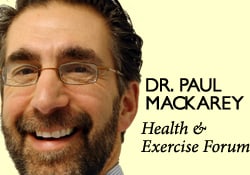
EVERY MONDAY – Read Dr. Paul J. Mackarey “Health & Exercise Forum!” at https://mackareyphysicaltherapy.com/forum/
This article is not intended as a substitute for medical treatment. If you have questions related to your medical condition, please contact your family physician. For further inquires related to this topic email: drpmackarey@msn.com. Paul J. Mackarey PT, DHSc, OCS is a Doctor in Health Sciences specializing in orthopaedic and sports physical therapy. Dr. Mackarey is in private practice in downtown Scranton and is an associate professor of clinical medicine at GCSOM.
Due to social distances and other appropriate precautions during the COVID-19 pandemic, many people are filling the void in their lives with outdoor endurance exercises such as running, cycling, hiking etc. However, as summer is in full swing, with temperature and humidity rising, remembering to properly hydrate is essential.
Next to oxygen, water is the nutrient most needed for life. A person can live without food for a month, but most can survive only three to four days without water. Even though proper hydration is essential for health, water gets overlooked as one of the six basic nutrients. Dehydration occurs when the amount of water taken into the body is less than the amount that is being lost. Dehydration can happen very rapidly (i.e. in less than eight hours); the consequences can be life threatening and the symptoms can be alarmingly swift.
In the body, water is needed to regulate body temperature, carry nutrients, remove toxins and waste materials, and provide the medium in which all cellular chemical reactions take place. Fluid balance is vital for body functions. A significant decrease in the total amount of body fluids leads to dehydration. Fluids can be lost through the urine, skin, or lungs. Along with fluids, essential electrolytes, such as sodium and potassium, are also perilously depleted in a dehydrated individual.
The risk of dehydration is not limited to endurance athletes and outdoor enthusiasts. Dehydration is the most common fluid and electrolyte disorder of frail elders, both in long term care facilities and in the community! Elders aged 85 to 99 years are six times more likely to be hospitalized for dehydration than those aged 65 to 69 years.
Is water adequate to prevent dehydration? Will a sports drink improve my performance? While some answers to these questions apply generally to all, others vary according to the temperature, humidity, length of time and intensity of the activity and condition of the athlete.
Proper hydration is essential for the comfort and safety of the recreational and serious athlete. Hydration is critical to maintain cardiovascular function, body temperature and muscle performance. As temperature, humidity, intensity, and duration of exercise increase, so too does the importance of proper hydration. Excessive sweating can lead to a loss of blood volume which requires the heart to work much harder to circulate you blood through your body.
Dehydration is a major cause of fatigue, loss of coordination, and muscle cramping leading to poor performance. Prehydration, (drinking before exercise) is the first step in preventing dehydration. Marathon runners, other long-distance runners, and cyclists often prehydrate1-2 days before a big event. Rehydration, (drinking during or after exercise) is the second step in preventing dehydration. While athletes may be more vulnerable to dehydration, all persons engaging in exercise would benefit from increased performance, delayed muscle fatigue and pain by maintaining adequate hydration. Proper prehydration would include drinking 12-16 ounces of water 1-2 hours before exercise. Athletes with other health issues should consult their family physician before engaging in long distance endurance sports.
NEXT MONDAY – Read Dr. Paul J. Mackarey “Health & Exercise Forum!”
For all of Dr. Mackarey articles visit https://mackareyphysicaltherapy.com/forum/
This article is not intended as a substitute for medical treatment. If you have questions related to your medical condition, please contact your family physician. For further inquires related to this topic email: drpmackarey@msn.com
Paul J. Mackarey PT, DHSc, OCS is a Doctor in Health Sciences specializing in orthopaedic and sports physical therapy. Dr. Mackarey is in private practice and is an associate professor of clinical medicine at GCSOM.
Part II of II
I think we would all agree, technology is a wonderful thing. However, like all good things, it comes at a price. Students and workers alike are suffering from the many physical effects of sitting for too many hours...especially with COVID-19 home confinement! Studies show the impact of prolonged sitting, especially with poor posture, are multifaceted: pain, headaches, vision problems, poor concentration, excess fat storage with weight gain. Studies strongly support the use of using good posture, ergonomic workstations, posture stretches and frequent changes of positions, including the use of standing desks to prevent pain and injury as we discussed last week in part I.
The Problem is Gravity!
The average head weighs 10 to 12 pounds and when tilted down at a 45 degree angle the forces of gravity are multiplied by 5. While reading, studying or working on the computer with poor posture, one must support 50 or more pounds of pressure on the neck, middle and lower back for hours on end. It is no wonder why this activity is associated with headaches, neck and back pain, numbness and tingling in arms and legs, muscle spasms etc. Some studies report the lifetime prevalence of neck and shoulder pain in office workers as high as 80%.
Spine problems can be prevented with good posture and proper body mechanics. Poor posture and improper body mechanics subject the spine to abnormal stresses that, over time, can lead to degeneration and pain. Good posture and proper body mechanics and frequent changes in positions, can minimize current spine pain and prevent recurrent episodes. Posture is the position in which you hold your body upright against gravity. Good posture involves positions that place the least amount of stress on the spine. Good posture maintains the spine in a “neutral” position. In a neutral spine, the three normal curves are preserved (a small hollow at the base of the neck, a small roundness at the midback and a small hollow in the low back). When viewed from the side, the upper back appears straight with a small hollow in the lower back.
GOOD POSTURE
Standing: Feet should be shoulder width apart. Distribute body weight evenly through both feet. Do not lock knees. Maintain a small hollow in lower back with “tailbone” slightly tucked down. Lift the breastbone by drawing shoulder blades back and down. Make chin level. Earlobes should be in line with the middle of shoulders. Relax jaw and neck muscles by resting tongue on the roof of mouth.
Sitting: Sit in a firm, high-back, straight-back chair. Buttocks should touch the back of chair while maintaining a small space between the back of knees and the seat of the chair. Distribute body weight evenly on both hips. Maintain an arch in the low back. A lumbar roll is recommended. It is a foam roll, 4” to 5” in diameter and 12” long, placed at belt level. Place feet flat on the floor with hips and knees bent at a right angle. Keep knees even with or slightly higher than hips. Use a footstool or footrest if necessary. Do not cross legs! Lift the breastbone by drawing shoulder blades back and down. Earlobes should be in line with the middle of shoulders. Position the armrests properly allowing elbows and forearms to rest with shoulders relaxed. If armrests are too high shoulders will shrug up and if too low will cause slouching.
POSTURE EXERCISES
The following exercises should be performed throughout the day as a break from sitting, studying or working at home, school or the office. They should be performed gently, slowly, held for 3-5 seconds and repeated 5-10 times. The exercises should only cause a slight stretch but NOT PAIN.
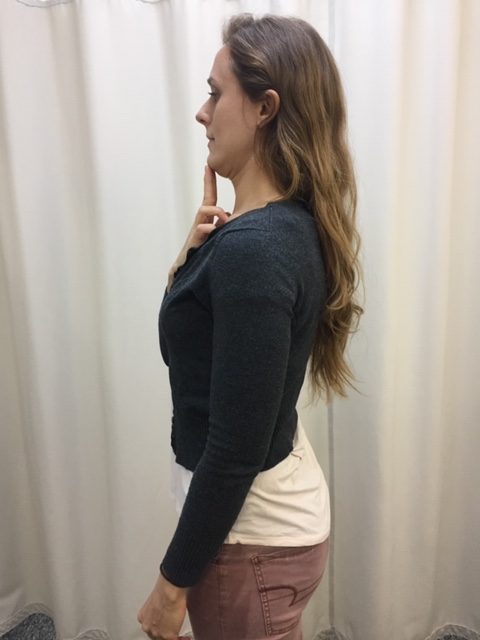
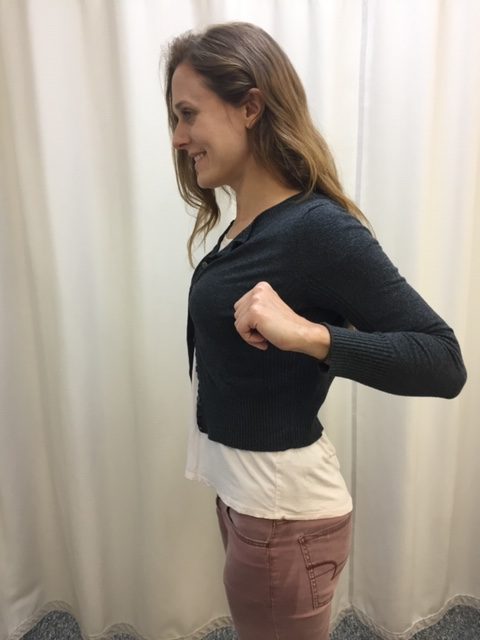
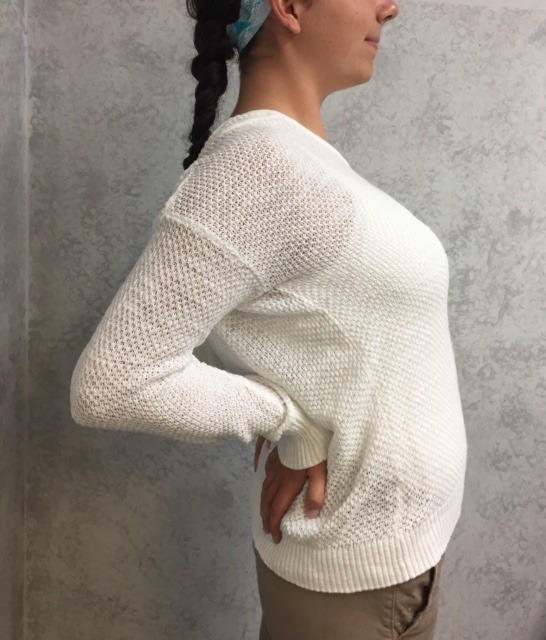
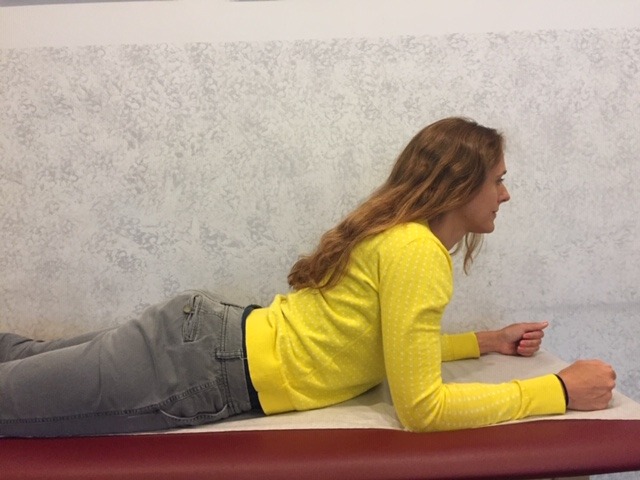
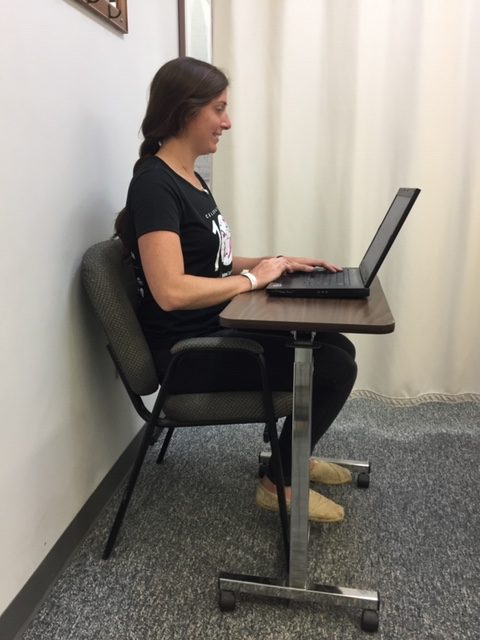
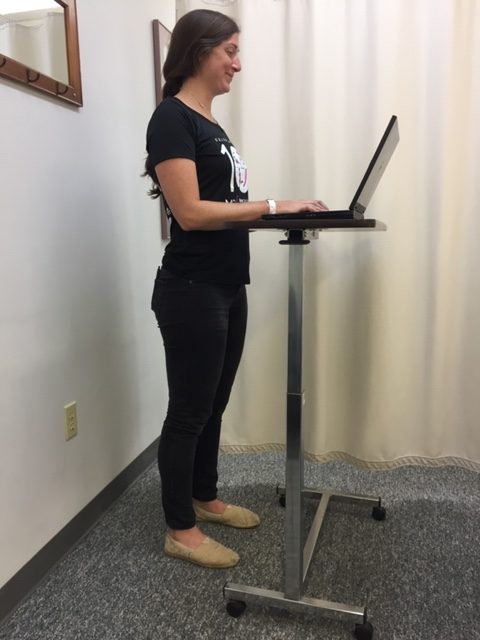
For all of Dr. Mackarey's Articles visit our health care forum at https://mackareyphysicaltherapy.com/forum/
Dr. Mackarey’s Health & Exercise Forum – every Monday
This article is not intended as a substitute for medical treatment. If you have questions related to your medical condition, please contact your family physician. For further inquires related to this topic email: drpmackarey@msn.com. Paul J. Mackarey PT, DHSc, OCS is a Doctor in Health Sciences specializing in orthopaedic and sports physical therapy. Dr. Mackarey is in private practice and is an associate professor of clinical medicine at Geisinger Commonwealth School of Medicine.
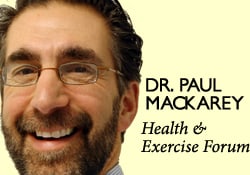
One positive outcome of the home confinement during the pandemic is that many people are spending more time than usual getting fit. However, when it comes to exercise, like many things, there is a right way and a wrong way to do it. And, as with many topics in the health and fitness world, there are many, many misconceptions about exercise. Here are my top ten most common exercise myths!
FALSE – Why pain is different than discomfort…
Muscle soreness and “feeling the burn” can occur during a normal healthy exercise routine. However, you should never experience a sharp, deep, intense or lingering pain during or after exercise. In fact, if the soreness lasts more than 24-48 hours, than you did more damage than benefit to your muscles and other tissues and it is time to scale back and take time off. If necessary, use RICE (rest, ice compression and elevation). It is important to get in tune with your body and learn the difference between muscle strain and fatigue discomfort and pain from soft tissue damage from overuse and overload. Find the proper amount of weight and repetitions and gradually increase over time.
2. Always Stretch Before you Exercise.
FALSE – This is not always the best advice
There is no solid evidence that stretching alone before a sport or activity prevents injury. In fact, over stretching may be counterproductive before a sport as it may weaken the muscle. The current wisdom on the matter is; never stretch a cold muscle. Instead, warm up for 5-10 minutes by actively moving the extremities and light jogging or biking and THEN lightly stretch the arms, legs, back etc. More vigorous stretching should be performed to improve the flexibility of tight muscles (ie calf and hamstring muscles) and best done after your workout but not before a sporting activity (tennis, basketball, etc.).
3. Lifting Weights Will Make you Bulky.
FALSE – Depends on your hormones
It is very unlikely that women and pre pubescent males will bulk up from lifting weights…especially light weights (blame or thank hormones). It will, however, increase metabolism and fat burning efficiency which can lead to weight loss and good muscle tone. Stick with low resistance and high repetitions for best results.
4. With the Correct Program, Spot Reduction Can be Achieved
FALSE – It is not possible to target an area of the body to burn more fat
It is very common for women to ask for a specific exercise to reduce the fat in their buttocks, thighs and abdomen. Regretfully, it is not possible to target weight loss in these areas or other body parts. In fact, when you lose weight through diet and exercise, the caloric expenditure will be evenly distributed throughout the body. However, once the adipose tissue in a specific part of the body such as the abdomen is reduced from general weight loss, targeting the area with exercises specific to that muscle group will improve the tone and definition for a leaner look in that region.
5. If you don’t have 45-60 Minutes to Exercise, Don’t bother.
FALSE – The research on this topic does not support it
Sure, it would be great to dedicate 60 minutes 5 -6 days a week for exercise. But for most of us who work and raise a family it is not practical. The good news is that the research supports 30 minutes of exercise 3-5 days a week. Moreover, evidence shows that 10 minutes, three times a day, 5 days per week will help you attain the 150 minutes a week supported in most exercise studies.
6. If you have Arthritis, Exercise will make it worse.
FALSE – There is no evidence to support this…but it supports the opposite.
Most people with the most common form of arthritis, osteoarthritis, feel better when they are moving. That is not to say that they don’t have increased symptoms when they OVERDO it. An exercise program specifically designed for a person’s problem and limitations will improve their symptoms and function. For example, if an individual has arthritis in their knees, they should use an exercise bike (partial weight bearing) or swim (buoyancy effect of water) instead of walk or run (full weight bearing) for aerobic exercise. Furthermore, they would do far better with light cuff weights in a sitting or lying position to strengthen their legs than performing squats or lunges. It is important to remember, the weight gain and joint weakness and stiffness associated with a sedentary lifestyle will do more harm to an arthritic joint than a proper exercise program.
7. You Need a Sports Drink When you Exercise
FALSE – Not unless you are planning a killer workout
The number one reason most of us exercise is to lose or control body weight. With this in mind, high calorie sports drinks are counterproductive and unnecessary. If you do not plan on exercising for more than 60 minutes, good old fashion H2O is more than adequate. However, if you plan to do a “killer” workout for more than 60 minutes and may incorporate a high intensity interval training (HIIT) program, than a sports drink with electrolytes and other nutrients, may be of value.
8. Exercise Machines are Better than Free Weights
FALSE – For most of us, effective resistance training is not about the equipment
It is safe to say, caveman was pretty fit and strong despite the fact that he never went to a gym and lifted weights. He did however, lift, push, pull, and carry heavy stones, timber, and animals for day to day survival. So too, it is for modern man, the body does not distinguish between the resistance provided by a elastic band, dumbbell, or cable with pulleys and weight stacks. As long as the basic principles of strength training are applied, (isolating a muscle or muscle group, loading the muscle with enough force to bring it to fatigue without causing tissue damage, and allowing for adequate rest and recover) than the muscle will gain strength regardless of the type of resistance.
9. Running is Better Than any other Form of Aerobic Exercise
FALSE – Don’t tell that to competitive swimmers
First, let me confess that I love to run and up until recently, ran almost daily. However, now that I am over 60, I had to find new forms of aerobic exercise which would be kinder and gentler to my joints. So, I mix it up between biking (indoors and outdoors, recumbent and upright), brisk walking or hiking, elliptical and stepper and swimming laps. Again, like the caveman weight lifting example, the body (heart and lungs) does not know what is causing an increase in heart rate for 30, 45 or 60 minutes, it only knows that it must respond to allow the body to function under this stress. And, in the process it becomes conditioned to the point that it will work much more efficiently when not under stress with a lower heart and respiratory rate and blood pressure at rest.
With this in mind, those over 50 would be well-advised to engage in low-impact aerobics on a regular basis. For example, if you want to run two to three days per week, do not run two days in a row and consider performing low impact exercise in between. Some examples of low impact aerobics are: walking, treadmill walking, swimming, elliptical trainer, and an exercise or road bike.
10. If You Never Stop Exercising than you won’t have to adjust your exercise program as you age.
FALSE - Why Change is Necessary with Age…
For many years, I have repeatedly preached about the value of engaging in an active lifestyle throughout life. It is especially important to be active as one gets older in order to maintain mobility and independence. However, many take this advice to an extreme and refuse to accept the inevitable changes that occur in the body with age. They run, jump, lift and throw like a teenager and often fail to modify their activity or exercise regimen appropriately for their age. Consequently, they suffer from multiple injuries, including muscle tears, tendonitis, bursitis, impingement and advanced osteoarthritis. Keep in mind, everyone ages differently. One person at 60 years of age may be the equivalent of another at 50. However, change with age is inevitable, so be kind to your body…it’s the only one you have! It is always prudent to consult your physician and physical therapist for a program designed specifically for your needs.
For more myths about exercise check out this youtube video! https://www.youtube.com/watch?v=yWLVsTWPcY0
For more of our Scranton Times articles check out our Health and Exercise Forum page: https://mackareyphysicaltherapy.com/forum/
NEXT MONDAY – Read Dr. Paul J. Mackarey “Health & Exercise Forum!”
This article is not intended as a substitute for medical treatment. If you have questions related to your medical condition, please contact your family physician. For further inquires related to this topic email: drpmackarey@msn.com
Paul J. Mackarey PT, DHSc, OCS is a Doctor in Health Sciences specializing in orthopaedic and sports physical therapy. Dr. Mackarey is in private practice and is an associate professor of clinical medicine at GCSOM.
Guest Columnist: Catherine Udomsak, DPT

Patients frequently ask me about the merits of yoga, from relaxation to flexibility. Many say, they are too busy or they don’t know enough about it. Well, in light of the fact that everyone has been forced to spend more time indoors, slow down and try new things, now may be a good time to try yoga.
It is hard to believe that yoga, which is now a cultural mainstay, was once considered a foreign practice. An ancient discipline that totes numerous health benefits, yoga is meant to cultivate inner peace, enlightenment, and a strong relaxed body. In the past, only major cities housed yoga studios but over time yoga has spread into small towns across the country. Studios offer a variety of classes and each promotes their own unique philosophy. Whether you are looking for a new workout regime, compliment to your current program or simply to quiet your mind in a hectic world, yoga may be an option for you.
Yoga is a discipline that developed over 5,000 years ago and is generally recognized as an ancient system for wellbeing. The word yoga, from the Sanskrit word “yuj”, literally means to yoke or to bind together. The primary focus of yoga is to harmonize or unite the mind, body, and spirit through a combination of poses, breathing techniques, and meditation.
The specific origin of yoga is a topic of debate. However, it is said to have originated in India and was brought to the Western world by yoga gurus in the late 19th and early 20th centuries. The basis for most current yoga practices is The Yoga Sutras of Patanjali. In The Yoga Sutras, eight limbs of yoga are specified. The three most common limbs are meditation, pranayama or breathing exercises, and asana which are the physical poses. Yoga classes can vary greatly, however, most classes include a combination of meditation, breathing exercises, and physical postures.
There are numerous styles of yoga. If you are a newcomer, deciding on a yoga class may be difficult. It is always a smart idea to call a studio before attending a class to gain information and have any questions answered. Furthermore, if you have any health concerns you may want to consult your doctor prior to trying a new form of exercise. Some common forms of yoga include but are not limited to:
Hatha - Hatha yoga is a general broad-based term referring to any type of yoga that teaches physical postures. Typically, one will find Hatha classes to be slow and gentle and a great option for beginners.
Vinyasa - This type of yoga focuses on the coordination of breath with movement. In Vinyassa yoga classes you can expect a continuous flow of movement from one posture to the next. Classes can be fast paced and are often appealing to those looking for a more strenuous workout.
Iyengar - Unlike Vinyassa, this type of yoga focuses on holding postures for a period of time to bring the body into it’s best alignment. If you attend this type of yoga class you can expect to use props including yoga blocks, blankets, and straps.
Ashtanga - This type of yoga follows a specific sequencing of postures. This rigorous form of yoga always performs the same postures, in the same order at each class and is typically fast paced.
Bikram - Typically performed in rooms heated to 105 degrees Fahrenheit and 40% humidity, the heat warms muscles and allows a deeper stretch. The difference between Bikram and Hot yoga is that Bikram follows a specific sequence of 26 poses from which hot yoga often deviates.
Yin Yoga - This meditative practice is perfect for those who want to calm their mind. In this type of yoga, poses are held for 5 minutes or longer. The purpose is to apply a deep stretch to the connective tissue (the tendons, fascia and ligaments) to improve flexibility.
Restorative - Best for those who want to focus on relaxing and taking some time to slow down. Most restorative yoga classes will be slow moving with longer hold times to allow deep relaxation.
Below you can find a few common yoga poses or asanas that can be found in beginner classes. These poses promote flexibility and strength and can be incorporated into your everyday workout routine. Remember, before you attempt the poses, begin by walking, biking or running to warm up. Don’t overstretch, perform slowly, and hold the position. You should feel mild discomfort NOT pain.
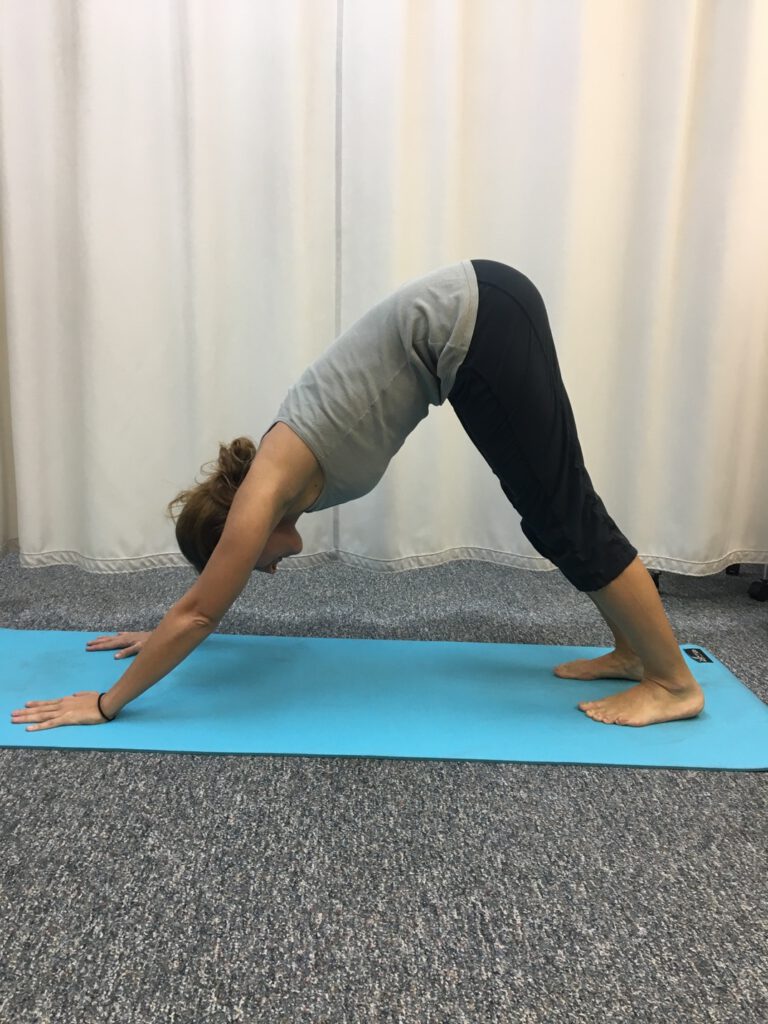
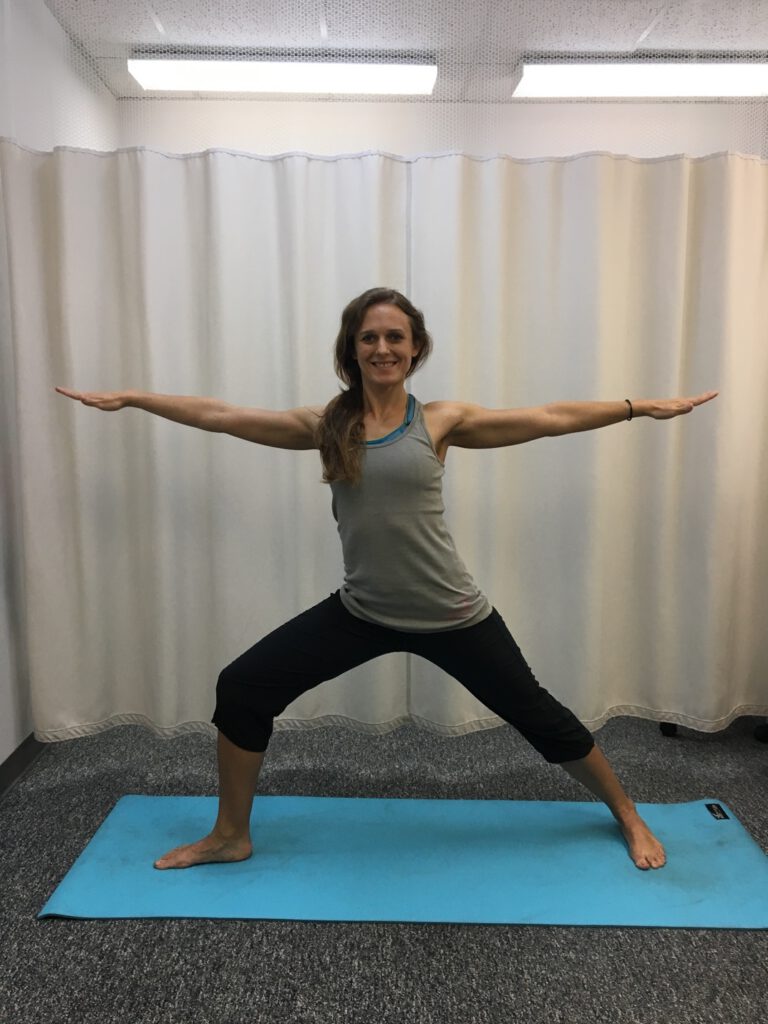
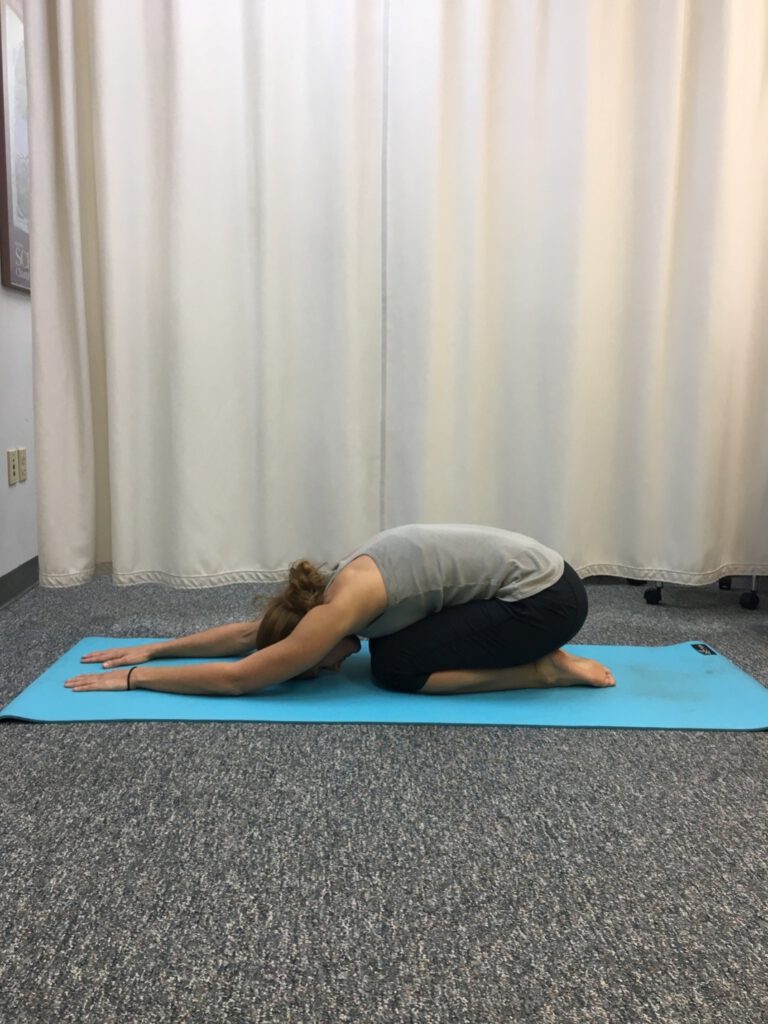
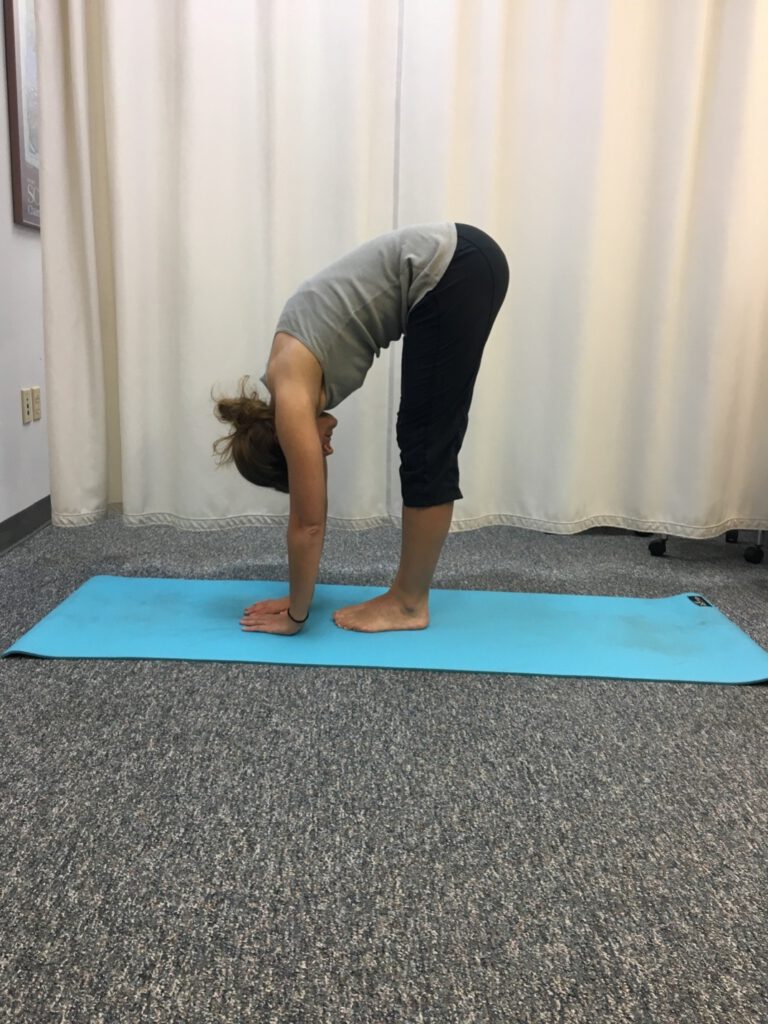
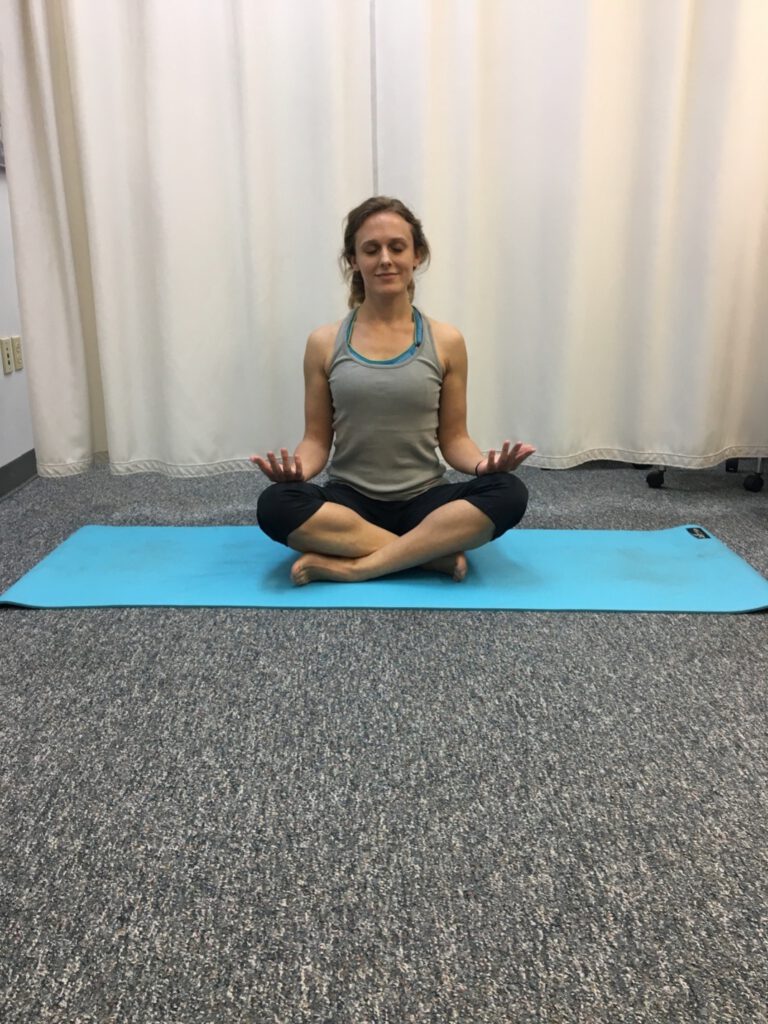
There are a lot of options when it comes to where to start to practice yoga. It is important that the studio you choose employs certified yoga instructors who have completed comprehensive training. A good instructor can make all the difference in your yoga experience. The studio should provide a clean environment and offer a variety of classes including beginner level if you are a newcomer. The best way to get a feel for a studio is to stop in for more information. You may want to ask about pricing as there are often discount introductory rates. Ask about rentals if you do not own a yoga mat and request to see the space. Some yoga studios have a strong sense of community while others are more like a gym. Try out a few different places until you find a fit for you.
Guest Columnist: Catherine Heimrich, DPT is a doctor of physical therapy and is an associate at Mackarey & Mackarey Physical Therapy Consultants, LLC in downtown Scranton, where she works with outpatient orthopedic and neurological patients. She has a special interest in vestibular and balance problems.
Model: Sarah Singer, PTA
Read Dr. Mackarey’s "Health & Exercise Forum" every Monday in the Scranton Times-Tribune.
This article is not intended as a substitute for medical treatment. If you have questions related to your medical condition, please contact your family physician. For further inquires related to this topic email: drpmackarey@msn.com
Paul J. Mackarey PT, DHSc, OCS is a Doctor in Health Sciences specializing in orthopaedic and sports physical therapy. Dr. Mackarey is in private practice and is an associate professor of clinical medicine at Geisinger Commonwealth School of Medicine.

A healthy immune system may be the difference between recovery from illness and dying. While you may not be able to improve an otherwise healthy immune system, you can take steps to maintain its health and integrity. Exercise is one of the best ways to maintain a healthy immune system.
With the closing of fitness centers, school gyms and exercise classes due to COVID-19, it may be a good time to begin a home exercise program that is quick and easy. For some, home exercises can be done before or after working from home to gain or maintain muscle tone. For others, home exercises may help maintain independence and safety performing daily activities around the house such as; climbing stairs, getting in and out of a shower, putting on shoes and socks, cooking, cleaning, and carrying groceries or laundry.
I have comprised 10 simple exercises including upper and lower body and balance and core. The only equipment you will need is a chair and resistance bands; yellow has the least resistance, black the most, red, green, blue in between. They can be purchased at any sporting goods or department store.
Remember, for most people it is more harmful not to exercise, so contact your physician to discuss whether independent exercise is appropriate for you. If you have special needs, you may need to consult with a physical therapist to get started. Good luck…I hope this helps you survive the COVID-19 quarantine!
These exercises are performed while sitting in a chair with a backrest, slowly. Hold the position for 3 seconds. Perform 5 -10 repetitions. Do these exercises 3-5 times per week. Begin with a yellow light resistance band.
Row the Boat (PHOTO 1)
Saw Wood (Photo 2)
Elbow Extension (Photo 3)
Hip Spread (Photo 4)
Hip Hike (Photo 5)
Leg Kicks (Photo 6)
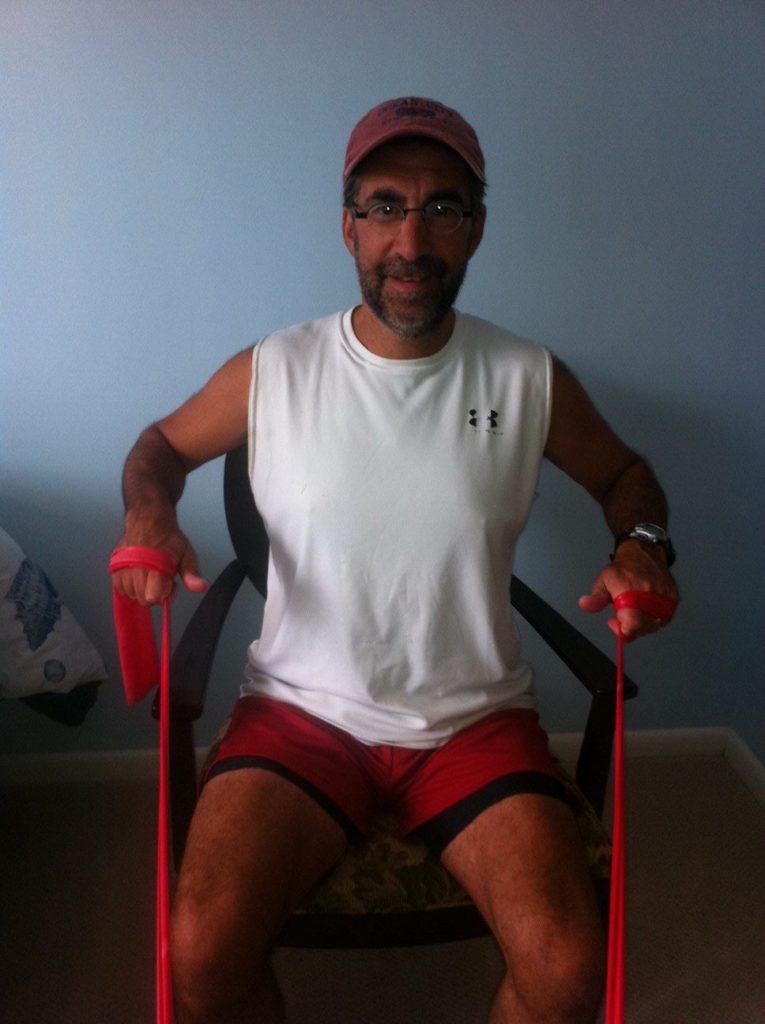
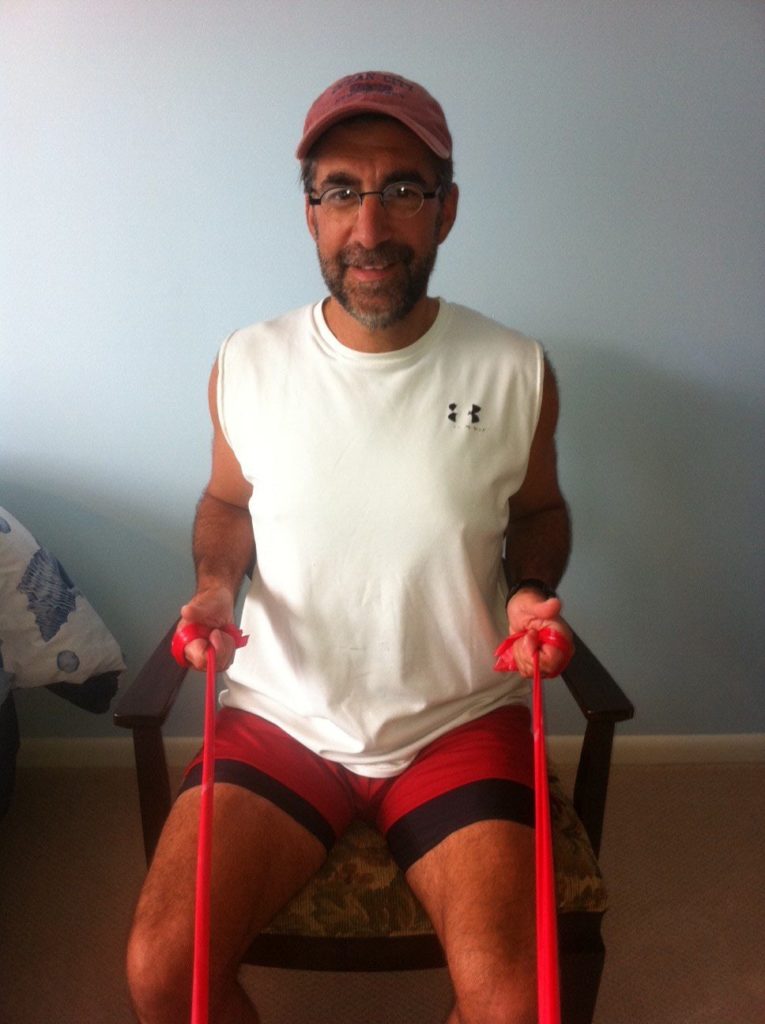
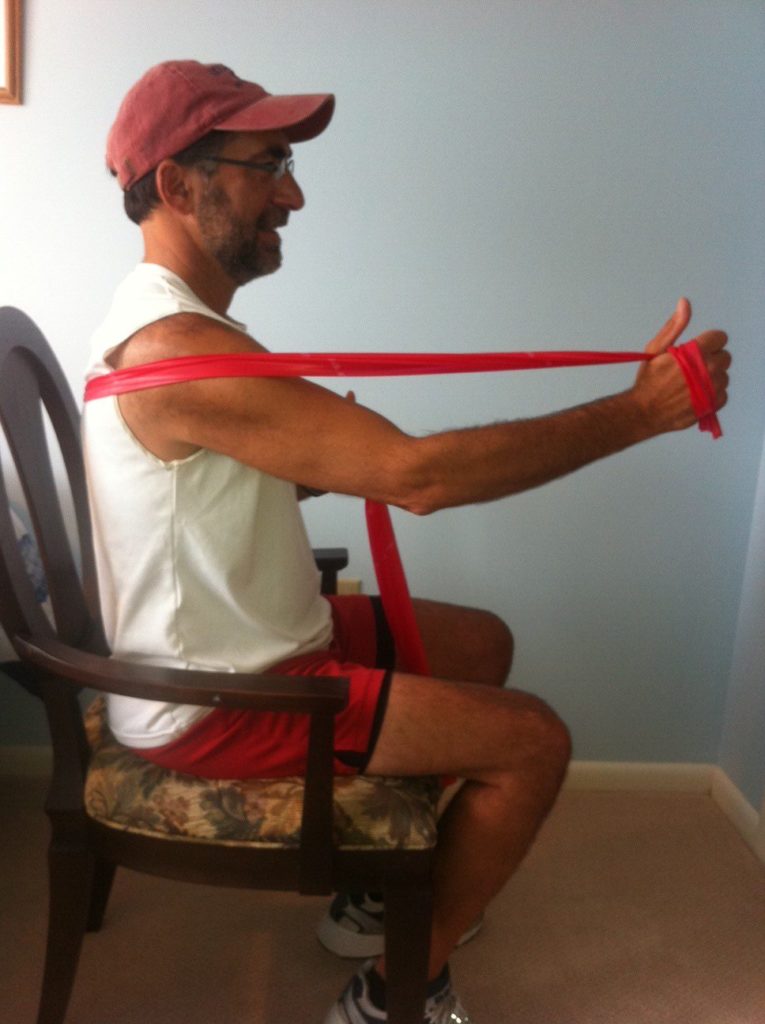
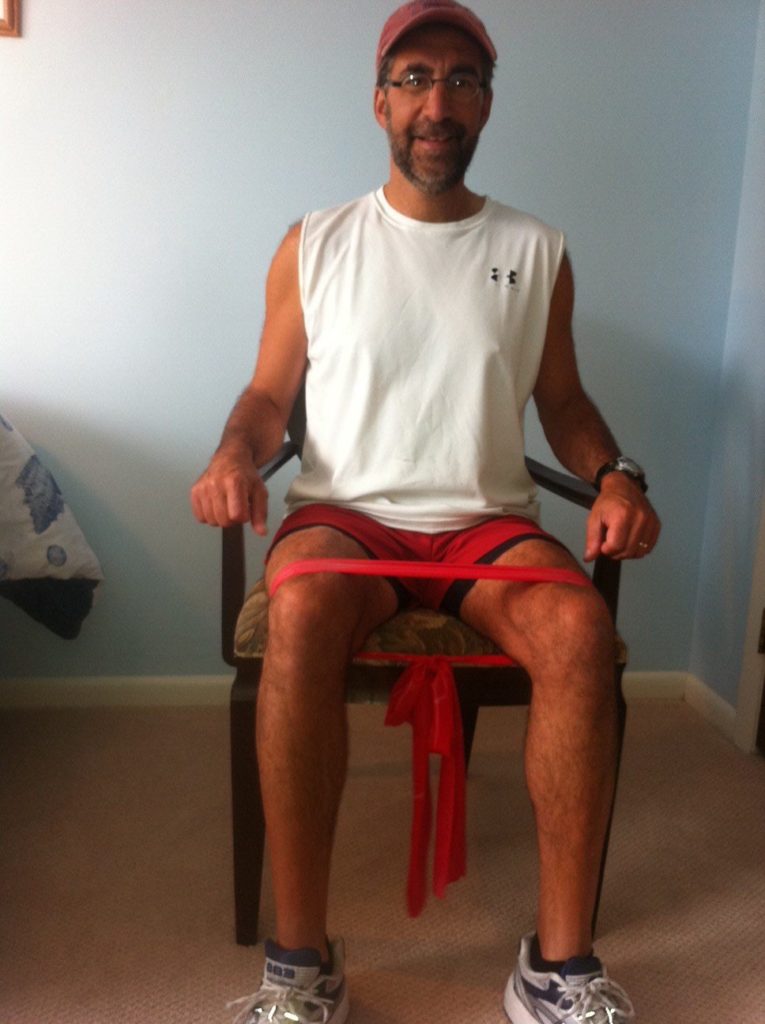
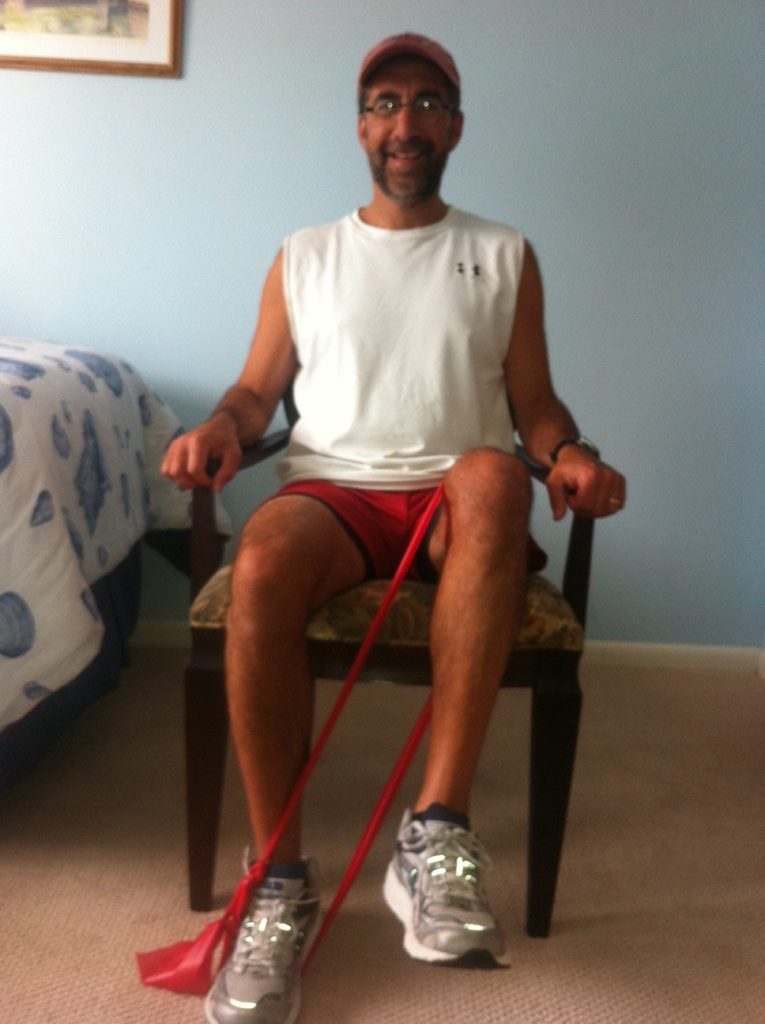
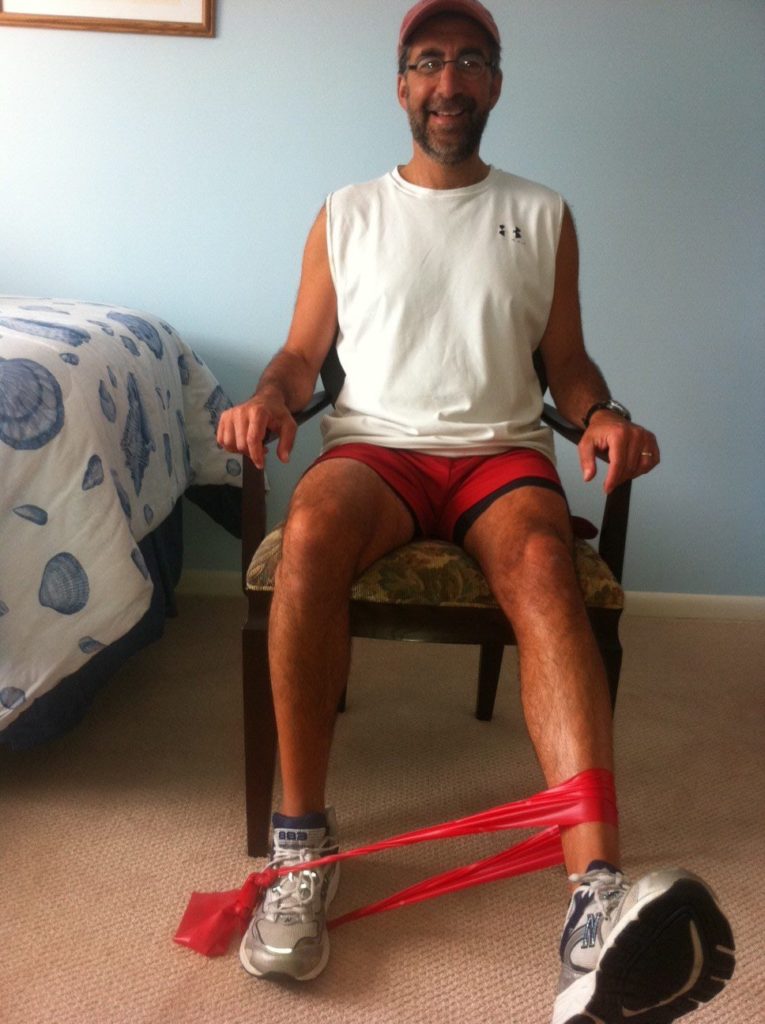
Shoulder Shrug (Photo 7)
Elbow Bend (Photo 8)
Standing Leg Curl (Photo 9)
Standing Walk Aways - Backward (Photo 10)
Standing Walk Aways - Forward
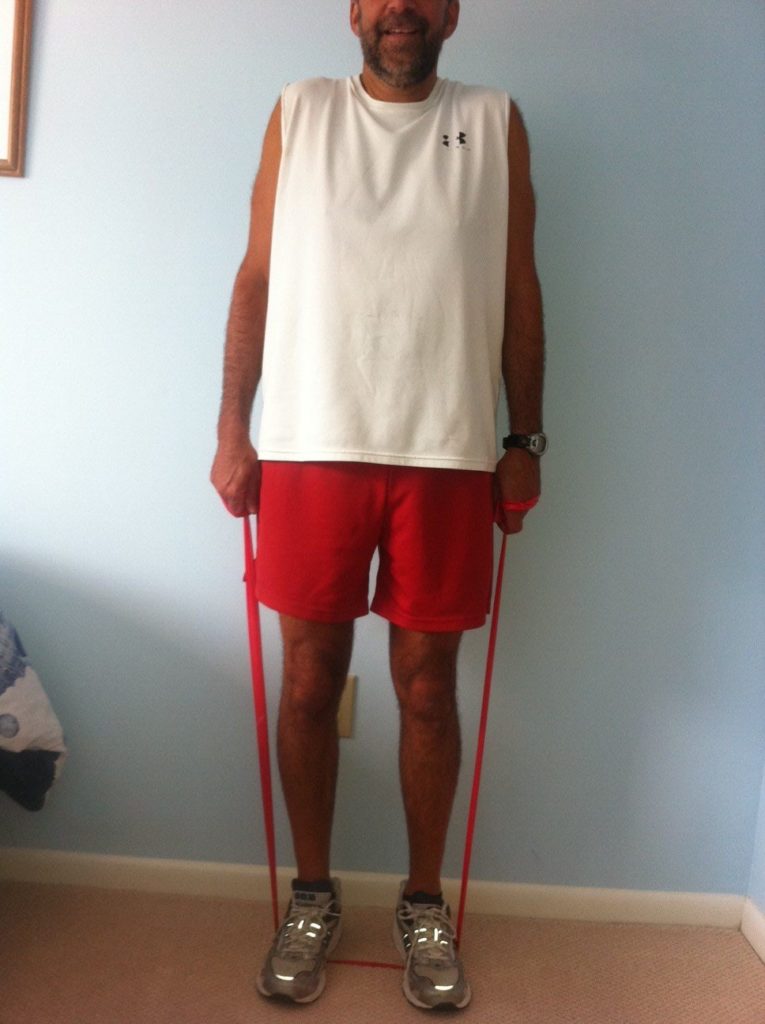
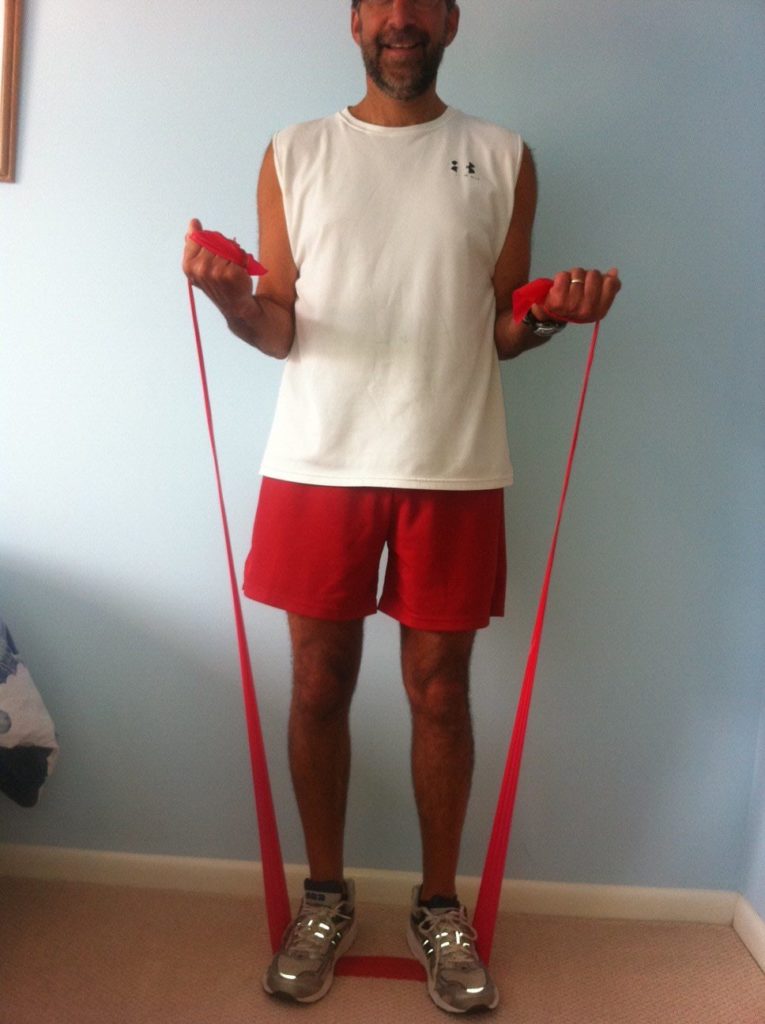
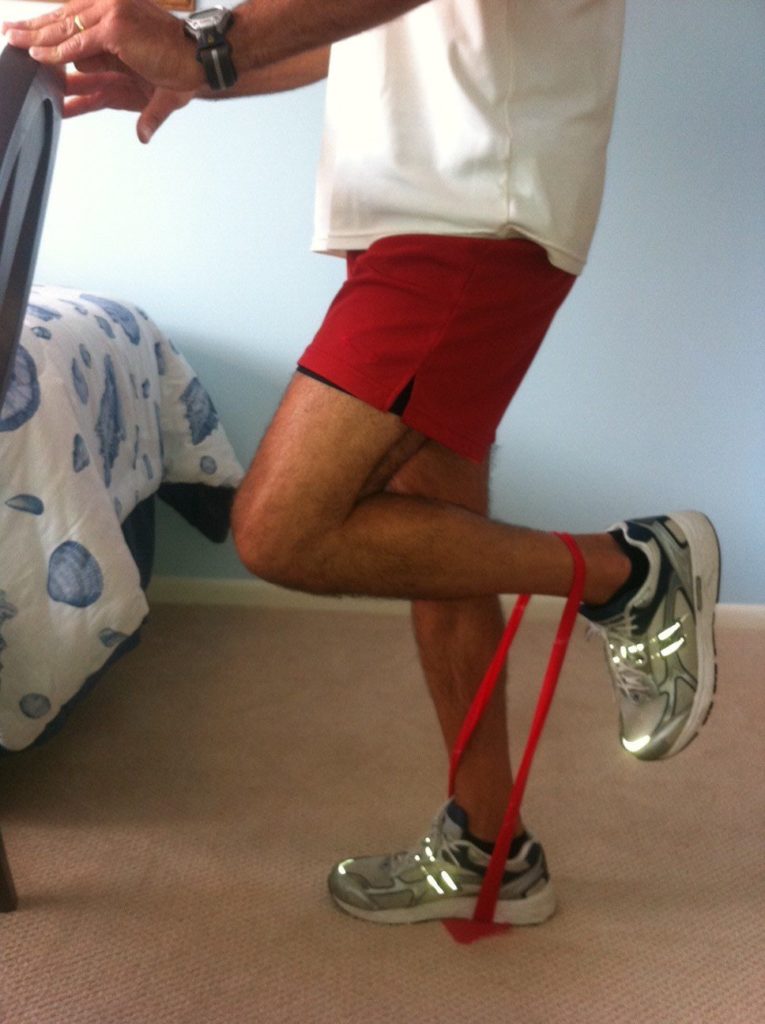
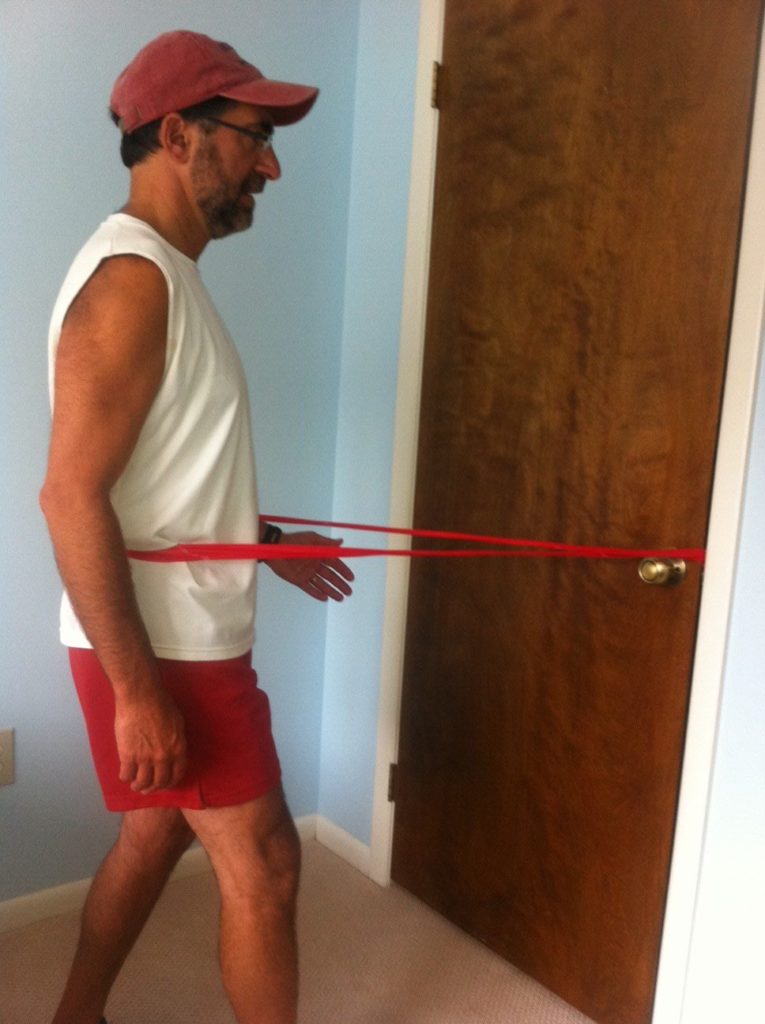
Visit your doctor regularly and listen to your body.
Keep moving, eat healthy foods, exercise regularly, and live long and well!
Read Dr. Mackarey’s "Health & Exercise Forum" every Monday in the Scranton Times-Tribune.
This article is not intended as a substitute for medical treatment. If you have questions related to your medical condition, please contact your family physician. For further inquires related to this topic email: drpmackarey@msn.com
Paul J. Mackarey PT, DHSc, OCS is a Doctor in Health Sciences specializing in orthopaedic and sports physical therapy. Dr. Mackarey is in private practice and is an associate professor of clinical medicine at Geisinger Commonwealth School of Medicine.

The human body is designed to defend against foreign bodies such as germs, bacteria, and viruses, including COVID-19. A healthy immune system may foster a speedier recovery from illness. While you may not be able to improve an otherwise healthy immune system, you can take steps to maintain its health and integrity.
A healthy immune system protects us by creating a barrier that stops invaders or antigens, from entering the body. When an unwelcome invader slips through the barricade, the immune system responds by producing white blood cells and other chemicals and proteins that attack the foreign substances.
Is there a secret to a long and healthy life? Do genes control our destiny? How does lifestyle impact our health? According to the National Institutes of Health (NIH), while genes play an important role, lifestyle plays the biggest role on how healthy you are and how long you live. The food you eat, what you drink, if you smoke, how active you are and how you handle stress are critical factors that determine your longevity. The NIH research has found that smoking, physical inactivity, and poor eating habits are the leading causes of death, in that order.
To maintain a healthy immune system, physical activity is one of the most important factors in improving a lifestyle in a positive way. A minimum of 30 minutes of physical activity, 5 days per week can greatly contribute to longevity. Most experts agree that moderation is important. If you overindulge with exercise you will be at greater risk for musculoskeletal injuries. This is especially true for those who are newcomers. The goal is to gradually work into a fitness program and maintain it for life…now, during home confinement; it may be a good time to begin.
Researchers have found that the benefits of regular physical activity are numerous. Some of the more important benefits are:
Sources: WebMD.
Visit your doctor regularly and listen to your body.
Keep moving, eat healthy foods, exercise regularly, and live long and well!
Next Week: Learn some simple home exercises using Resistance Bands.
Read Dr. Mackarey’s "Health & Exercise Forum" every Monday in the Scranton Times-Tribune.
This article is not intended as a substitute for medical treatment. If you have questions related to your medical condition, please contact your family physician. For further inquires related to this topic email: drpmackarey@msn.com
Paul J. Mackarey PT, DHSc, OCS is a Doctor in Health Sciences specializing in orthopaedic and sports physical therapy. Dr. Mackarey is in private practice and is an associate professor of clinical medicine at Geisinger Commonwealth School of Medicine.
Prevention of Shoulder Injuries in Tennis: Strengthening. Part 1 of 2
HAPPY MEMORIAL DAY! You can tell that summer is in the air, not only by the arrival of the sunshine, warm air and longer days, but also by the beautiful sound of a tennis ball hitting a racquet hitting at Scranton Tennis Club and Birchwood Racquet and Fitness Club. So, get your racquets out and join the fun! However, take time to “tune up” in order to prevent injury, especially to the shoulder. In a sport that relies so heavily on the use of the shoulder, it is very common for tennis players to develop occasional shoulder pain or a more chronic problem such as shoulder rotator cuff tendinitis. That is exactly what happened to professional tennis star, Maria Sharapova and many others over the past few seasons.
For many, tennis is more of a seasonal sport. For example, in high school it is played in the fall for girls and spring for boys. In the off-season, a shoulder can lose much of its essential strength. This loss will result in a deconditioned shoulder at the start of the season and making it more susceptible to injury. Practicing with a deconditioned shoulder commonly results in sprain, strain and pain. Pain and weakness will significantly interfere with the ability to perform at a high level.
To prevent shoulder problems, one must participate in an exercise program specifically designed for tennis. A well-balance shoulder strengthening program includes rotator cuff and scapular (shoulder blade) muscle exercises, reeducation, biomechanics, and a stretching program pre and post hitting. This column will discuss some of these principles to properly prepare your shoulder for the tennis season and avoid injury.
STRENGTHENING EXERCISES FOR TENNIS
To avoid shoulder pain it is necessary to maintain shoulder strength. Stretching exercises are also important and will be discussed in next week in, Prevention of Shoulder Injuries in Tennis - Part II. Strengthening exercises need to concentrate on three groups of muscles: power muscles (the large muscles of the shoulder), shoulder blade stabilizer muscles (the muscles which stabilize the shoulder blade, and the all important rotator cuff muscles (the muscles which move the shoulder and control the cocking and follow through phases of the tennis stroke, while keeping the joint in proper position). Strengthening the power muscles of the shoulder is fairly easy; latissimus pull downs, pectoralis bench presses, and bicep curls will cover all bases. While these exercises are important in maintaining strength and power of the throwing shoulder, they are not as important as the exercises for the shoulder stabilizers and rotator cuff muscles.
PHOTO 1 - Rotator Cuff Internal Rotation (Tennis Forehand Stroke): Holding a light or medium resistance band, imitate a forehand stroke with slight bend in the elbow…can be performed with band tied to tennis racket.
PHOTO 2- Rotator Cuff External Rotation (Tennis Backhand Stroke): Holding a light or medium resistance band, imitate a backhand stroke with slight bend in the elbow. can be performed with band tied to tennis racket.
PHOTO 3- Latissimus Pull downs – Kneeling or sitting:
PHOTO 4- Bench Press - Lying on back with knees bent
PHOTO 5- Biceps Curls - Sitting or standing
Models: Katherine Weaver, SPT & Lauren Calvey
Visit your doctor regularly and listen to your body.
Contributor: Gary E. Mattingly, PT, PhD: Professor Emeritus, University of Scranton, Dept. of Physical Therapy
NEXT MONDAY – Read Dr. Paul J. Mackarey “Health & Exercise Forum” in the Scranton Times-Tribune. Part 2 “Prevention of Shoulder Injuries in Tennis”
This article is not intended as a substitute for medical treatment. If you have questions related to your medical condition, please contact your family physician. For further inquires related to this topic email: drpmackarey@msn.com
Paul J. Mackarey PT, DHSc, OCS is a Doctor in Health Sciences specializing in orthopaedic and sports physical therapy. Dr. Mackarey is in private practice and is an associate professor of clinical medicine at Geisinger Commonwealth School of Medicine.